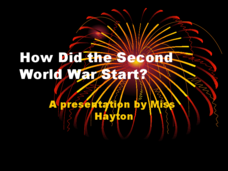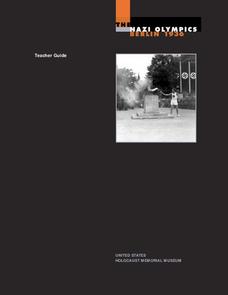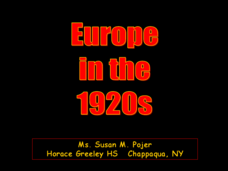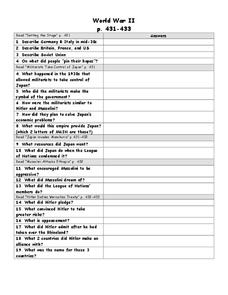Curated OER
Adolph Hitler
A collage of stark images from World War II compose the background of this presentation about Adolph Hitler. The infamous leader's childhood, rise to power, and eventual defeat are detailed in these slides, filling in many gaps that...
Curated OER
Hitler's Lightning War
When you line them up, you can knock them down. Hitler had a plan, carried it out, and started WWII. This presentation focuses on Hitler's military and political tactics, who he fought, and how his opponents fell. Key players and events...
Curated OER
Children and World War II
Intended for a younger audience, this presentation provides a very simplistic overview of the people and events key to World War II. They will be introduces to Hitler, Chamberlain, and Churchill, hear an audio piece, and see images from...
Curated OER
How Did WWII Start?
How did the second world war begin? A presentation first looks at the political climate that led to WWI and the effects of that war. Then, it describes the reason Hitler was able to take hold of Germany after WWI and prior to WWII. The...
Carolina K-12
Introduction to the Holocaust
Young historians gain a well-rounded insight into the tragedy of the Holocaust by exploring pre-war Jewish life, reading and discussing survivor testimonies, and illustrating their understanding by using their own words and those of a...
American Battle Monuments Commission
The Strategic Bombing Campaign
An extensive look at World War II details the strategic bombing campaign of the Allied forces. Beginning in September 1939 and ending in May 1945, the interactive map follows British and American forces throughout the bombing campaigns...
US Holocaust Museum
Nazi Olympics: Berlin 1936
The Olympics are about more than sports—at times, the games are also a place of racism and prejudice! Pupils investigate the 1936 Olympics in Berlin, Germany. They analyze the meaning behind the materials included in the United States...
US National Archives
WWII: Western Europe 1939-45 – Occupation
Warsaw, Poland, suffered much of the blunt of World War II—but according to Polish letters from the early days of Nazi occupation, other parts of the country were much worse off. High schoolers use the letters and contemporaneous...
US National Archives
WWII: Western Europe 1939-45 – Resistance and SOE
Germany seemed to be unstoppable in the early years of World War II, but the tireless and sacrificial work of the Special Operations Executive (SOE) helped to steer the war in another direction. After exploring primary source documents,...
US National Archives
WWII: Western Europe 1939-45 – Deception and Bluff
World War II left the British desperate for help in any form—including in the form of a magician! High schooler conduct research on Jasper Maskelyne, a stage magician who used his talents to deceive the Germans on the war front, before...
US National Archives
WWII: Western Europe 1939-45 – End of the War
You are Winston Churchill, and on May 9th, 1945, you receive millions of grateful cards and telegrams. How do you respond? High schoolers put themselves in the Prime Minister's chair with an activity that prompts them to respond to a...
US National Archives
Eastern Europe 1939-45 — Berlin
The inevitability of World War II has arrived: Berlin has fallen. Young historians watch contemporaneous footage of the event, analyze primary source documents, and write a news report that details the roles of the Soviet, British,...
US National Archives
Eastern Europe 1939-45 — Camps
Britain's decision not to bomb German death camps in World War II has provided many questions for historians, but with a primary source analysis lesson, high school students may be a step closer to finding out the truth. Learners read...
US National Archives
Eastern Europe 1939-45 — Ukraine
Was Joseph Stalin desperate or exaggerating the USSR's need for assistance on the Eastern Front in 1942? History students examine two differing opinions on Stalin's position and the reality of the Eastern Front just three years before...
US National Archives
WWII: Asia 1939-45 – Singapore
The fall of Singapore in World War II was shocking news for the Allied forces—but why? High schoolers explore primary source documents and videos to determine why February 15, 1942 was a wake-up call to the British Empire and its allies...
US National Archives
WWII: The Atlantic 1939-45 – Battle of the Atlantic
The most dangerous line of attack during World War II wasn't the German planes soaring above Britain, but the U-Boats cutting off their supplies of food and equipment. Learners research the Battle of the Atlantic, the German campaign to...
US National Archives
WWII: The Pacific 1939-45 – Japan and the Atom Bomb
Though the scientists who developed the atom bomb did not believe it should be used to end World War II, American President Harry S. Truman and British Prime Minister Winston Churchill were of like mind in their decision to drop the bomb...
Curated OER
Escaping the Holocaust: Incorporating the Voyage of the St. Louis
Students research passengers aboard the St. Louis to explore the difficulties Jewish refugees faced when fleeing Nazi Germany. They research print and online resources, construct histories of individual passengers on the St. Louis.
Curated OER
Europe in the 1920s
Delicately poised after the dramatic end of WWI and the startling beginning of WWII, this presentation encompassing the positions and roles of Germany, Italy, England, France, and the League of Nations in the 1920's. The first half of...
Curated OER
Julius Caesar
Famous Dictators and their main traits are listed on each slide in this Julius Caesar presentation. Important facts and events from each leaders' life accompany a picture which will keep your students' attention. There are some facts out...
Curated OER
Master Race
Students view a short film on the rise of Nazism and its main principles. They read first hand accounts of Kristallnacht and identify turning points in Hilter's foreign policy. They write a newspaper article describing what happened...
Curated OER
World War II
In this World War II study guide worksheet, students respond to 19 short answer questions. The questions correlate to assigned readings in a textbook.
Curated OER
The Holocaust
In this Holocaust history study guide worksheet, students read a brief overview pertaining to the Holocaust and then respond to a reflection question.
Curated OER
Adolf Hitler Fascist Totalitarian Dictator
In this Adolf Hitler study guide worksheet, pupils read a brief overview pertaining the Fascist totalitarian dictator and then respond to 3 reflection questions.

























